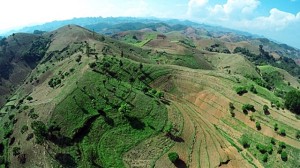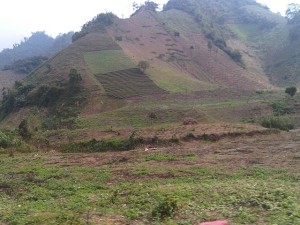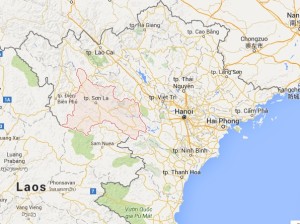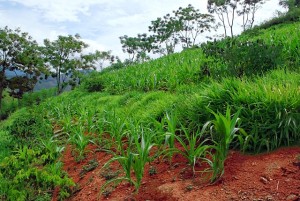Originally published at Agroforestry World Blog

After five years, the proven benefits of agroforestry have inspired farmers to expand from plots to entire landscapes. Nguyen Anh Thu and Tran Ha My write about the benefits of a project under the CGIAR Research Program on Forests, Trees and Agroforestry that is supported by the Australian Centre for International Agricultural Research.
A project in the harsh environment of Northwest Viet Nam, led by the World Agroforestry Centre, set out in 2011 to find solutions to land degradation and poverty among smallholders. It started on a small scale with experimental agroforestry systems on individual farmers’ land. But as the benefits of the project began to be realized with tangible impact on income and land degradation, the methods of the project and its agroforests are now being expanded to entire landscapes.
The north-western region of Viet Nam is plagued with hardship. Deforestation and forest degradation have left the steeply sloping hills vulnerable to serious soil erosion. Much of the area’s biodiversity has been wiped out.
The populations living in these uplands, largely ethnic minority groups, suffer from the highest rates of poverty in the country. While many remain subsistence farmers, dependent on the land for their livelihoods, years of monocultural cultivation of maize have exacerbated degradation of their land, leading to further soil and water loss and nutrient depletion. Yields have declined, lowering farmers’ already meagre incomes. Harsh weather worsens these conditions, in some cases causing loss of crops in the monocultural systems that have little protection from the elements. All this leaves farmers with few alternatives.

Recognizing that agroforestry could alleviate these issues and benefit both farmers and the environment in many ways, the World Agroforestry Centre (ICRAF) began the Agroforestry for Livelihoods of Smallholder Farmers in Northwest Viet Nam (AFLI) project in 2011. It is managed in partnership with local governments in the region’s provinces, and supported by the Australian Centre for International Agricultural Research and the CGIAR Research Program on Forests, Trees and Agroforestry.
The initial phase of the project established agroforestry experimental plots on land volunteered by smallholders. Ten different systems were tested, all of which intercropped maize with several species of fruit trees and fodder grasses. Over the course of the past five years, a total of 71 of these ‘volunteer farmers’ have been intensively trained in agroforestry techniques, ranging from establishing nurseries and preparing seedlings through grafting and marcotting techniques to design of agroforestry systems. Even though the trees are still in early stages of development after five years, the experiments are already producing environmental benefits and economic gain for the smallholders.

Following this initial success in Son La Province, the project is now expanding. ICRAF took smallholders from Son La who were not involved in the experiments to visit the AFLI sites. After witnessing the benefits of agroforestry for themselves, over 30 households voluntarily came forward to participate in AFLI’s next phase.
Together with these households and the government’s agricultural advisory centres, ICRAF has established a 50 hectare model landscape in Mai Son, Son La. Approximately 50,000 metres of forage grass have been planted along contour lines on sloping land using a buffalo-led technique taught by experts from ICRAF in the Philippines. Across the landscape, 22,000 trees of different fruit varieties—including longan, mango, plum, pomelo and lime—are being planted. AFLI is also replicating this landscape model on 50 hectares in Tram Tau, Yen Bai Province.
These successes are based on the initial experimental plots on farmers’ land, which tested systems such as one that mixed late-fruiting longan trees with maize and forage grass. This system proved it was able to maintain maize yields compared to monocultural practices while also producing forage grass for use on farms or for sale as livestock feed.

One smallholder in the experiment found that with the additional forage grass he was able to increase his livestock from just one buffalo to three in a few years. The longan trees are expected to begin fruiting in their fourth year and bring in considerable income. Very importantly, the experimental system has already reduced soil erosion by 40–45% compared to monocultural maize cultivation.
In addition to such on-farm experiments, group nurseries were established to provide seedlings for the experimental plots and ICRAF researchers trained farmers in techniques such as grafting and marcotting, a plant-propagation technique. Now the farmers are successfully managing the nurseries themselves. Advisory material on other management techniques, such as top-working and pruning was also published.
While the positive effects of the AFLI project were clear to farmers their positive effects were also noticed by local authorities. In witnessing the real impact agroforestry has had on both smallholders’ livelihoods and the environment, the People’s Council of Yen Bai incorporated the scientific innovations into policies for sustainable cultivation practices on sloping land in poor areas. Incentives include a subsidy of VND 1 million per hectare for farmers to grow grass strips to prevent soil erosion, which will also increase maize yields and provide feed for livestock, and a subsidy of VND 6 million for every hectare of ‘son tra’ (Docynia indica) trees planted in Tram Tau and Mu Cang Chai districts.
The heavily degraded land and poverty of the region may soon be things of the past thanks three key factors: the willingness of smallholders to take the risk of testing new agroforestry systems, the support of the local governments and the foresight of the Australian Centre for International Agricultural Research in understanding the benefits of trees on farms that have been proven by the World Agroforestry Centre.











